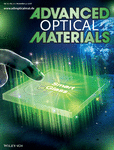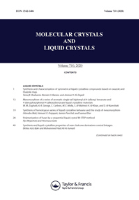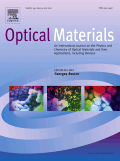
Advanced Optical Materials
Scope & Guideline
Connecting Scholars with the Frontiers of Optical Science
Introduction
Aims and Scopes
- Optical Materials Development:
Research on the synthesis, characterization, and optimization of materials that exhibit unique optical properties, including photoluminescence, nonlinear optical behavior, and thermal stability. - Advanced Photonic Devices:
Exploration of new photonic devices such as light-emitting diodes (LEDs), lasers, sensors, and displays, with an emphasis on improving performance metrics such as efficiency, wavelength tunability, and operational stability. - Nanostructured and Hybrid Materials:
Investigation of nanostructured materials and hybrid systems that combine organic and inorganic components to enhance light-matter interactions and enable novel functionalities. - Nonlinear Optical Effects:
Studies focusing on nonlinear optical phenomena, including second harmonic generation, upconversion, and other processes that enable advanced applications in photonics and telecommunications. - Optoelectronic Applications:
Research on the integration of optical materials into optoelectronic devices, including solar cells, photodetectors, and other technologies that utilize light for energy conversion and information processing. - Biomimetic and Smart Materials:
Development of materials inspired by natural systems, enabling dynamic optical properties and responsive behaviors for applications in sensors, displays, and environmental monitoring.
Trending and Emerging
- Lead-Free Perovskite Materials:
Research on lead-free alternatives to traditional perovskites is gaining momentum, driven by environmental concerns and the need for sustainable materials in optoelectronic applications. - Hybrid and Composite Materials:
There is an increasing focus on hybrid materials that combine organic and inorganic components, enabling enhanced optical properties and multifunctionality for applications in sensors, LEDs, and photovoltaics. - Ultrafast and Nonlinear Optical Phenomena:
Studies exploring ultrafast light-matter interactions and nonlinear optical effects are gaining traction, particularly in the context of new materials that facilitate advanced photonic applications. - Quantum Dots and Nanocrystals:
The application of quantum dots and nanocrystals in various optoelectronic devices is expanding, with researchers investigating their unique properties for applications in displays, sensors, and imaging. - Smart and Responsive Optical Materials:
Emerging research on materials that respond dynamically to environmental stimuli, such as temperature, light, or electric fields, is becoming increasingly prominent, reflecting a trend towards adaptive optical systems.
Declining or Waning
- Traditional Organic Light-Emitting Diodes (OLEDs):
Research on conventional OLEDs, particularly those that do not incorporate advanced materials or novel architectures, seems to be waning as newer, more efficient materials and structures gain traction. - Basic Photonic Crystal Structures:
The emphasis on simple photonic crystal designs without complex functionalities or integration with other technologies appears to be decreasing, as researchers pursue more sophisticated and multifunctional designs. - Single-Component Materials:
There is a noticeable decline in studies focusing solely on single-component materials without hybridization or complex interactions, as the trend shifts towards multifunctional and composite systems. - Passive Optical Devices:
Research on passive optical devices, such as simple filters or basic lenses, is becoming less frequent, with a growing interest in active and tunable systems that offer enhanced capabilities. - Conventional Quantum Dots:
While quantum dots remain a vibrant area of research, the focus is shifting from traditional quantum dots to more innovative materials and hybrid systems that offer improved performance and new functionalities.
Similar Journals

Nonlinear Optics Quantum Optics-Concepts in Modern Optics
Charting New Territories in Nonlinear and Quantum OpticsNonlinear Optics Quantum Optics-Concepts in Modern Optics is a specialized journal published by OLD CITY PUBLISHING INC, focusing on the forefront of research in nonlinear optics and quantum optics. With an ISSN of 1543-0537 and an E-ISSN of 1944-8325, this journal serves as a pivotal platform for the dissemination of innovative concepts and findings in modern optics, significant for both theoretical exploration and practical applications. Established in 2003, the journal's scope encompasses critical areas such as atomic and molecular physics, optical materials, and instrumentation, attracting submissions from a diverse range of interdisciplinary fields. While the journal currently maintains a Q4 ranking in several categories, it continues to strive for higher visibility and impact in the academic community. Researchers and students alike will find valuable insights and contributions that foster advancements in optical science and engineering. With an emphasis on rigorous peer-review, Nonlinear Optics Quantum Optics-Concepts in Modern Optics is committed to enhancing the understanding and application of nonlinear optical phenomena in various technological domains.

APPLIED OPTICS
Pioneering Research for a Brighter TomorrowApplied Optics, published by Optica Publishing Group, is a prestigious journal dedicated to the field of optics and photonics. With an ISSN of 1559-128X and an E-ISSN of 2155-3165, this journal serves as a critical platform for researchers, professionals, and students eager to disseminate innovative findings and advancements in applied optics. Established in 1962, it has maintained a significant presence in the academic community, currently holding a Q2 category ranking in various disciplines including Atomic and Molecular Physics, Electrical and Electronic Engineering, and Miscellaneous Engineering as per the 2023 metrics. The journal's reputation is underscored by its solid Scopus rankings, attesting to its influential research output. While not an open-access journal, it continues to offer vital insights and discussions on the latest research topics that are critical to the advancement of technologies in optics, ensuring accessibility to vital knowledge for those within the field.

Optics is a pioneering open access journal published by MDPI, dedicated to advancing the field of optics and photonics. Since its inception in 2020, the journal has fostered the dissemination of high-quality research and innovative developments in optical sciences, contributing significantly to its community of researchers, professionals, and students in Switzerland and beyond. With an impact factor reflective of its growing prominence, Optics strives to address a diverse scope, encompassing atomic and molecular physics, electronic materials, and broader topics in physics and astronomy. The journal's commitment to open access ensures that cutting-edge research is freely available, promoting collaboration and knowledge-sharing across disciplines. As of 2023, it holds a Q4 ranking in several categories, including Atomic and Molecular Physics, and Optics, which illustrates its evolving role in the academic landscape, positioning it as a valuable resource for those seeking to explore the frontiers of optical technology and its applications.

MOLECULAR CRYSTALS AND LIQUID CRYSTALS
Connecting Chemistry, Physics, and Material ScienceMOLECULAR CRYSTALS AND LIQUID CRYSTALS is a distinguished journal published by Taylor & Francis Ltd, dedicated to the comprehensive examination of the structural and physical properties of molecular crystals and liquid crystals, with applications spanning fields such as chemistry, materials science, and condensed matter physics. Established in 1972, this journal has carved out a niche in the academic landscape despite facing recent challenges, as reflected in its current quartile rankings of Q4 across multiple categories in 2023. The journal not only serves as a platform for groundbreaking research but also invites contributions that further explore the intricate relationships between molecular organization and material properties, thereby advancing our understanding of these fascinating substances. With a commitment to fostering scientific dialogue, MOLECULAR CRYSTALS AND LIQUID CRYSTALS aims to reach a broad audience of researchers, professionals, and students, providing insights that are pivotal in driving innovation in materials research.

OPTICAL MATERIALS
Leading Insights in Material SciencesOPTICAL MATERIALS is a peer-reviewed journal published by Elsevier, focusing on the intricate field of optical materials within various scientific domains including atomic and molecular physics, electronic engineering, and chemistry. With an impact factor indicative of its relevance, it ranks in the Q2 category across multiple areas such as Electrical and Electronic Engineering, and Inorganic Chemistry, highlighting its critical position in advancing research and innovation. Established in 1992 and continuing its contribution until 2024, this journal serves as a vital resource for researchers and professionals aiming to disseminate significant findings in material sciences, particularly those related to optical properties and applications. While it does not offer open access, the journal remains essential for academia and industry alike, ensuring the continued exchange of valuable knowledge in this rapidly evolving field.

Acta Photonica Sinica
Advancing Knowledge in Atomic and Molecular PhysicsActa Photonica Sinica is a peer-reviewed academic journal published by SCIENCE PRESS, focusing on the fields of atomic and molecular physics and optics. Since its inception in 1997, this journal has provided a crucial platform for researchers and professionals to share cutting-edge findings and advancements in photonics and related areas. Despite its current positioning in the Q4 quartile for both atomic and molecular physics and optics, Acta Photonica Sinica remains a significant contributor to the scholarly community, fostering innovative discussions and collaborations. The journal does not currently offer open access, providing a selective but impactful repository of knowledge for readers in China and beyond. As the scientific landscape evolves, the journal aims to enhance its scope and impact, addressing the challenges and opportunities within the photonics domain. Researchers, students, and professionals interested in the latest theoretical and experimental studies will find a wealth of information that emphasizes the pivotal role of optics in scientific and technological advancements.

International Journal of Optics
Illuminating the Future of OpticsWelcome to the International Journal of Optics, a distinguished publication dedicated to advancing the field of optics and its interdisciplinary applications. Published by HINDAWI LTD, this open-access journal has been pivotal in fostering knowledge since its inception in 2009. With a robust focus on atomic and molecular physics as well as electronic, optical, and magnetic materials, the journal has carved its niche within Q3 quartile rankings in these categories for 2023, signifying its growing impact and relevance in the scientific community. Researchers and professionals will find a rich repository of innovative and cutting-edge research articles that not only address fundamental aspects of optics but also explore practical applications across various domains. The journal's aim is to promote high-quality research dissemination, enhancing collaboration among scientists and ensuring that pivotal findings reach a global audience. Join us in exploring the dynamic world of optics—where your contributions help shape the future of science.

OPTICS LETTERS
Advancing Knowledge in Optics and PhotonicsOPTICS LETTERS is a premier academic journal published by the Optica Publishing Group, dedicated to advancing the field of optics and photonics. Since its inception in 1977, it has maintained a strong reputation for publishing high-impact research, holding a distinguished Q1 category ranking in Atomic and Molecular Physics, as well as Optics, making it a vital resource for researchers and professionals alike. With an impressive Scopus rank of #55 out of 224 in its field, OPTICS LETTERS continues to shape the discourse and innovation in optical science. Authors benefit from its extensive international reach, while readers gain access to cutting-edge studies that address both theoretical and applied aspects of optics. Although the journal currently does not offer open access options, its rigorous peer-review standards ensure that every publication meets the highest academic criteria, making it an essential journal for anyone looking to stay at the forefront of optical research.

JOURNAL OF OPTOELECTRONICS AND ADVANCED MATERIALS
Fostering Collaboration in Cutting-Edge ResearchJOURNAL OF OPTOELECTRONICS AND ADVANCED MATERIALS, published by the NATL INST OPTOELECTRONICS in Romania, is an esteemed academic journal dedicated to disseminating innovative research in the fields of optoelectronics and advanced materials. With an ISSN of 1454-4164 and E-ISSN 1841-7132, the journal provides a platform for researchers to share their findings and technological advancements from 1999 to 2024. Despite being placed in the Q4 quartile across several categories—including Atomic and Molecular Physics, Condensed Matter Physics, and Electrical and Electronic Engineering—the journal serves as an essential resource for highlighting significant developments in its respective fields. Researchers and professionals may find valuable insights that foster collaboration and inspire further investigation, thereby contributing to the continuous evolution of optoelectronics and materials science.

Photonics, an esteemed journal published by MDPI, is a leading platform for researchers in the fields of atomic and molecular physics, optics, and instrumentation. Since its inception in 2014, the journal has fostered open access to cutting-edge research, facilitating knowledge dissemination in these dynamic disciplines. With its Q2 ranking in the 2023 Scopus metrics for various categories, including radiology, nuclear medicine, and imaging, Photonics represents a crucial academic resource for professionals and students seeking to advance their understanding and expertise. Located in Basel, Switzerland, the journal plays a pivotal role in bridging theoretical and practical approaches to photonic technologies. Researchers are encouraged to contribute their findings, thereby enriching the journal’s impact and relevance in the global scientific community through collaboration and innovation.